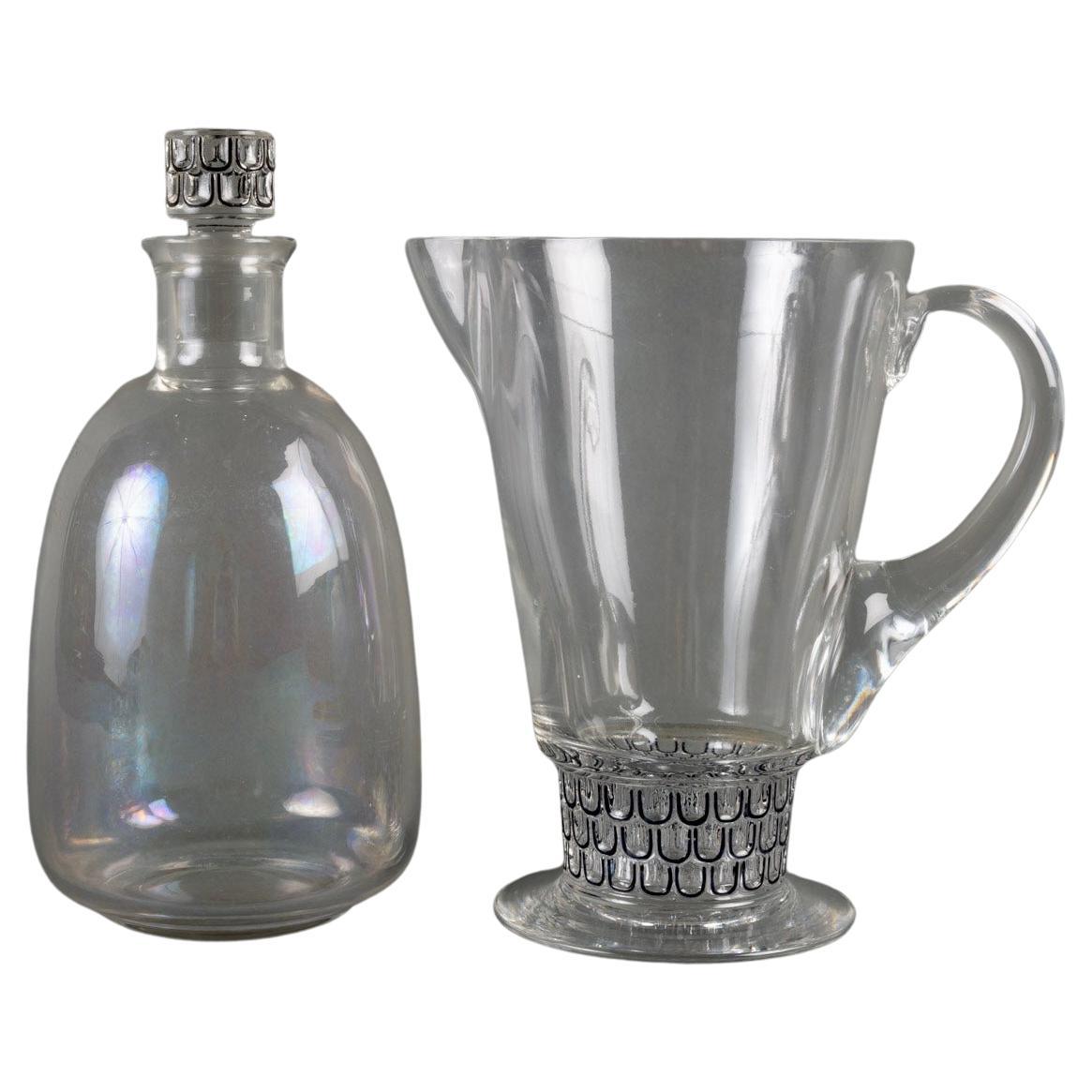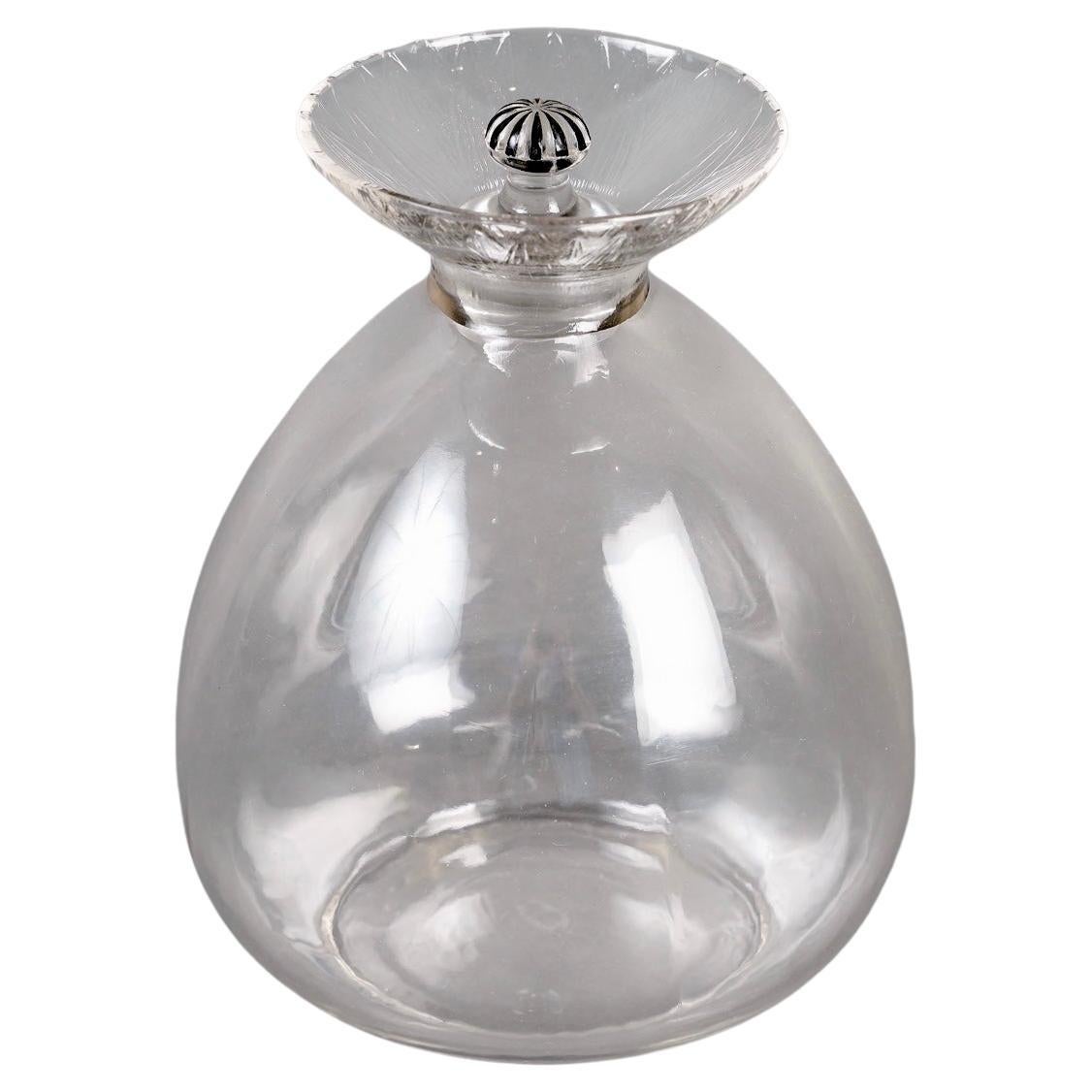René Lalique for Cusenier, Carafe, France, 1930s
About the Item
- Creator:René Lalique (Manufacturer)
- Dimensions:Height: 8.08 in (20.5 cm)Width: 5.12 in (13 cm)Depth: 4.41 in (11.2 cm)
- Style:Art Deco (Of the Period)
- Materials and Techniques:
- Period:
- Date of Manufacture:1930
- Condition:Additions or alterations made to the original: Slightly reduced carafe lip by master glass artisan. Wear consistent with age and use. Superb René Lalique Art Deco carafe created for Cusener. Handle in bronze scale iron oxidised decorations of foliage and berries. Signed "René Lalique pour Cusenier". Excellent condition. Some signs of use and slight deposits. Dimensions in cm ( H.
- Seller Location:PARIS, FR
- Reference Number:1stDibs: LU8131233002212
René Lalique
The career of the famed jewelry designer, glassmaker and decorative artist René Lalique spanned decades and artistic styles. Best known today for his works in glass, Lalique first won recognition for his jewelry. He was described as the inventor of modern jewelry by the French artist and designer Émile Gallé, and his luxurious naturalistic designs helped define the Art Nouveau movement. Later as a glassmaker in the 1920s and ‘30s, Lalique designed vases, clocks, chandeliers and even car hood ornaments that were the essence of Art Deco chic. Even now, the name Lalique continues to be a byword for a graceful, gracious and distinctively French brand of sophistication.
Born in 1860 in the Marne region of France, Lalique began his career as a jewelry designer in the last decades of the 19th century. His work employed now-classic Art Nouveau themes and motifs: flowing, organic lines; forms based on animals, insects and flowers — all rendered in luxurious materials such as ivory, enamel, gold and semi-precious stones. By 1905, Lalique had begun creating works in glass, and his style began to shift to a cleaner, sharper, smoother, more modern approach suited to his new medium. His Paris shop’s proximity to perfumer François Coty’s led him to experiment with beautiful perfume bottles. He offered the first customized scent bottles, transforming the perfume industry. By the end of the First World War, the artist had fully embraced Art Deco modernity, devoting himself to new industrial techniques of glass production and designs that manifest the sweeping lines and the forms suggestive of speed and movement characteristic of the style. Lalique’s work looked both backward and forward in time: embracing ancient mythological themes even as it celebrated modern progress.
Late in his career, Lalique took on high profile luxury interior design projects in Paris, Tokyo and elsewhere. He designed decorative fixtures and lighting for the interior of the luxury liner Normandie in 1935, and decorated the salons of well-known fashion designer Madeleine Vionnet. Today, Lalique’s influence is as relevant as it was when he opened his first jewelry shop in 1890. In a modern or even a traditional décor, as you will see from the objects offered on these pages, the work of René Lalique provides the stamp of savoir-faire.
- ShippingRetrieving quote...Ships From: PARIS, France
- Return PolicyThis item cannot be returned.
- René Lalique, Large "Dahlia" Perfume Bottle, France, 1930sBy René LaliqueLocated in PARIS, FRBeautiful and large Dahlia model René Lalique bottle, France 1930s. Signed R. Lalique. In excellent condition. Dimensions in cm ( H x W x D )...Category
Vintage 1930s French Art Deco Glass
MaterialsBlown Glass
- Daum France, Carafe, 1980sBy DaumLocated in PARIS, FRBeautiful Daum France carafe. Handle in glass paste of green and yellow hues and decorations of foliage and berries. Body in Daum Crystal. Signed Daum Fr...Category
Vintage 1980s French Art Nouveau Pitchers
MaterialsCrystal
- Baccarat, Honeycomb Carafe, France, 1980By BaccaratLocated in PARIS, FRSuperb carafe with decorations of hand cut honeycomb pattern in Baccarat crystal. Stamped by the manufacture. Excellent condition. Dimensions in cm ( H x L x l ) : 21.5 x 16.5 x 12 Secure shipping. Since 1764 Baccarat has written the chapters of its remarkable history in sparkling letters. Founded in Lorraine, by permission of King Louis XV, the world’s most famous Crystalworks has, over the ages, become a symbol of superb craftsmanship and French Art de...Category
Vintage 1980s French Regency Pitchers
MaterialsCrystal
- Lalique, "St-Hubert" Decanter, France 1980sBy LaliqueLocated in PARIS, FRBeautiful St-Hubert decanter by the Lalique Maison. Stopper with decorations of oak tree leaf. Signed Lalique France. In very good condition. Secure shipping. The Lalique Maison was created by René Lalique who was one of the greatest artists of his time, whether as a jeweler or master glassmaker. He marked the Art Nouveau and Art Deco periods with his unique style. Lalique is recognized as one of the most important jewelry designers and glass maker of the French Art Nouveau period, creating innovative pieces for Samuel Bing's new store in Paris, Maison de l'Art Nouveau. He began exhibiting his work under his own name as early as 1894, notably at the Salon des artistes français, 1897 and 1898. The great glassmaker Émile Gallé discovered him at the first one and praised him highly. His Stand at the 1900 Universal Exhibition in Paris was a great success. While keeping sources of inspiration from the Art Nouveau woman, fauna and flora - including the peacock, various insects and sometimes a fantastic bestiary - he innovated by using materials barely used for jewelry at the time: glass, enamel, leather, Horn, mother of pearl, often preferring semi-precious stones to precious stones. The introduction of volume in jewelry is facilitated by his knowledge in modeling. He designed his models, having them made by a team of chisellers, sculptors and enamellers that he carefully recruited. Many women from the nobility, the bourgeoisie and the entertainment world began to wear his extraordinary jewelry, such as the Marquise Arconati-Visconti, the Countess of Béarn, Madame Waldeck-Rousseau, and Sarah Bernhardt, for whom he created a stage costume in 1902 for the revival of the play Théodora at the Sarah-Bernhardt Theater. Lalique was the only modern artist whose client and friend Calouste Gulbenkian became. Gulbenkian acquired the famous Pectoral à la libellule (circa 1897-1898), a masterpiece much admired at the 1900 World's Fair, which he lent to the tragedienne Sarah Bernhardt. After the end of the First World War, Lalique's colorful and fantastic jewelry were no longer in fashion. The creator sensed this and decided to convert to the Art Deco style through glassware in 1920. Thus, the neo-classical and geometric Art Deco replaces Art Nouveau. According to Olivier Mauny, former CEO of Lalique, his creations paved the way for an industrialization of art objects, because one of the best ways to include luxury and aesthetics in everyday life is to make everyday objects. He will create many objects such as vases, cups, candlesticks, perfume bottles, radiator caps for the Citroën 5CV (1925), decorations for the restaurant cars of the Côte d'Azur Pullman Express (1929), decorations for the dining room of the first class of the Normandie liner...Category
Vintage 1980s French Art Deco Pitchers
MaterialsCrystal
- Lalique After René Lalique, Fontainebleau Service, France 1950sBy René LaliqueLocated in PARIS, FRSuperb Lalique Fontainebleau service composed of 41 pieces in sets of 8 and one carafe. This service has champagne coupes, water, red, white wine...Category
Vintage 1950s French Art Deco Glass
MaterialsCrystal
- Lalique After René Lalique, Five Fontainebleau Liquor Glasses, France 1950sBy René LaliqueLocated in PARIS, FRBeautiful Lalique Fontainebleau set of five liquor glasses. Other wine glasses from the same collection are available in the shop. In very good ...Category
Vintage 1950s French Art Deco Glass
MaterialsCrystal
- 1923 René Lalique Decanter Satyre for Cusenier Clear Glass with Sepia PatinaBy René LaliqueLocated in Boulogne Billancourt, FRRené Lalique "Satyre" decanter made in 1923 in molded clear glass with sepia patina. Engraved "R.LALIQUE POUR CUSENIER" signature on bottom. Perfect condition. Félix Marcilhac, Re...Category
Vintage 1920s French Art Deco Pitchers
MaterialsBlown Glass
- 1926 Rene Lalique Decanter & Pitcher Saint Nabor Glass Black EnamelBy René LaliqueLocated in Boulogne Billancourt, FRDecanter and Pitcher "Saint Nabor" made in clear glass woth original black heated enamel by René Lalique in 1926. Both pieces are signed on bottom. Perfect condition. Decanter need...Category
Vintage 1920s French Art Deco Pitchers
MaterialsBlown Glass
- 1920 René Lalique, Decanter Coquilles Glass with Blue Patina, ShellsBy René LaliqueLocated in Boulogne Billancourt, FRDecanter "Coquilles" made in clear and frosted glass with blue patina by René Lalique in 1920. Engraved signature. Perfect condition. height: 34.5 cm Félix Marcilhac, René...Category
Vintage 1920s French Art Deco Pitchers
MaterialsBlown Glass
- 1924 René Lalique - Decanter Lotus Clear Glass With Black EnamelBy René LaliqueLocated in Boulogne Billancourt, FRDecanter "Lotus" made in clear glass with original black enamel on stopper by René Lalique in 1924. Engraved signature on bottom. Perfect condition height: 17 cm Félix Marc...Category
Vintage 1920s French Art Deco Pitchers
MaterialsBlown Glass
- 1922 Rene Lalique, Decanter Gouttes D'Eau Clear Glass Water DropsBy René LaliqueLocated in Boulogne Billancourt, FRDecanter "Gouttes d'Eau" made in clear glass by René Lalique in 1922. Engraved signature on bottom. Perfect condition. Measures: Height: 30 cm. Félix Marcilhac, René Lalique - Cat...Category
Vintage 1920s French Art Deco Pitchers
MaterialsBlown Glass
- 1912 René Lalique, Decanter Deux Danseuses Clear Glass with Blue PatinaBy René LaliqueLocated in Boulogne Billancourt, FRDecanter "Deux Danseuses" made in clear glass with blue patina by René Lalique in 1912. Stamped signature. Perfect condition height: 34.5 cm Félix Marcilhac, René Lalique - Catal...Category
Vintage 1910s French Art Deco Pitchers
MaterialsBlown Glass






